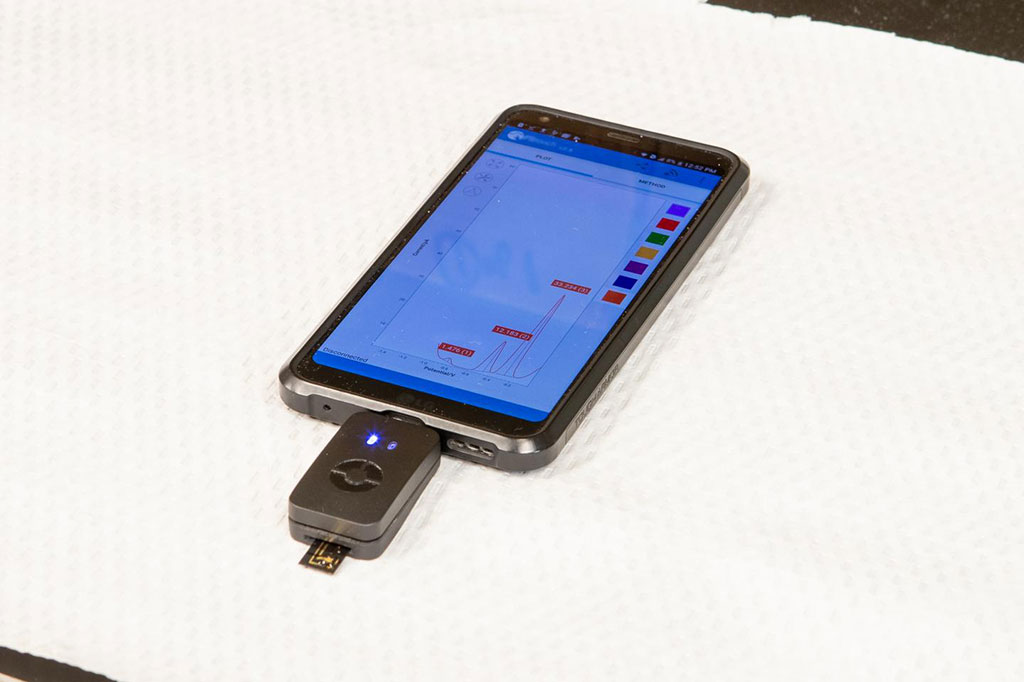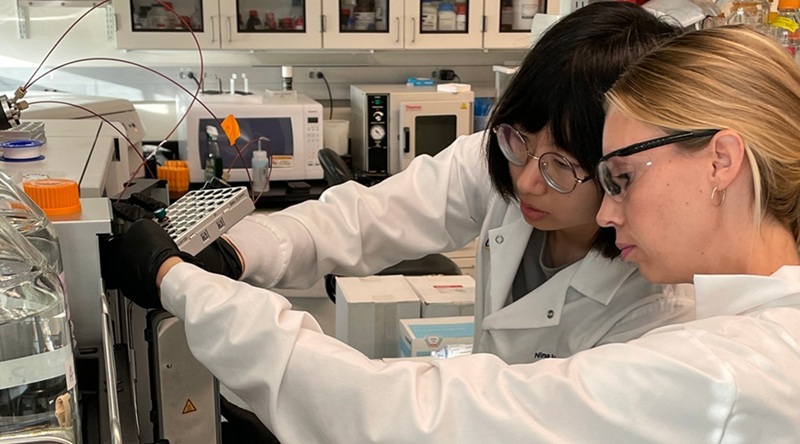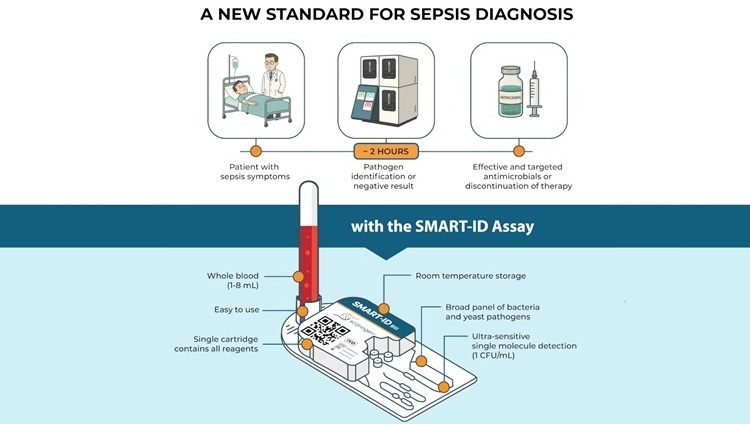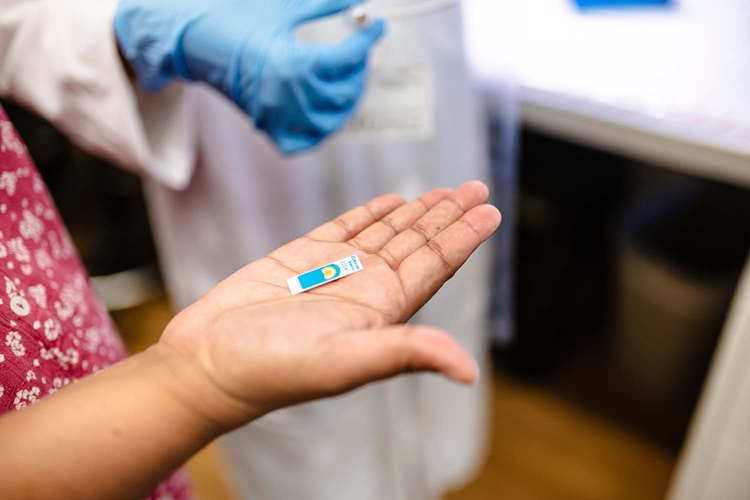An Electrochemical Bio-barcode Device for Home Disease Monitoring and Diagnosis
|
By LabMedica International staff writers Posted on 28 Oct 2020 |

Image: A recently developed electrochemical bio‐barcode device paired with a smartphone enables cancer patients to read critical biomarker levels at home in samples of self-drawn blood (Photo courtesy of Georgia Kirkos, McMaster University)
A point-of-care (POC) electrochemical bio‐barcode device and assay system have been developed to enable analysis of protein biomarkers in undiluted and unprocessed human plasma samples.
There is a need for biosensing systems that can be operated at the POC for disease screening and diagnostics and health monitoring. In spite of this, simple to operate systems with the required analytical sensitivity and specificity for clinical samples remain a rarity.
To correct this situation investigators at McMaster University (Hamilton, Canada) and Brock University (St. Catharines, Canada) devised an electrochemical bio‐barcode assay (e‐biobarcode assay) that integrated biorecognition with signal transduction using molecular (DNA/protein) machines and signal readout using nanostructured electrodes.
The design of the e‐biobarcode assay eliminated multistep processing and used a single step for analysis following sample collection into the reagent tube. In use, a drop of blood is added to a vial of reactive solution, and a small amount of the mixture is placed onto a strip and inserted into a reader. In minutes, the device determines the concentration of an antigen.
In the current study, the investigators demonstrated the clinically relevant determination of prostate specific antigen (PSA) - the biomarker for prostate cancer - in undiluted and unprocessed human plasma.
"This is another step toward truly personalized medicine," said senior author Dr. Leyla Soleymani, associate professor of engineering physics at McMaster University. "We are getting away from centralized, lab-based equipment for this kind of testing. This would make monitoring much more accessible and cut down on the number of times patients need to leave home to provide blood samples."
"Once commercialized, this device will be a paradigm shift for cancer diagnosis and prognosis," said contributing author Dr. Feng Li, associate professor of chemistry at Brock University. "Since this device is a lot more accessible and user-friendly than conventional technologies, patients will be more willing to use it, which can improve clinical outcomes and save lives."
The e‐biobarcode assay was described in the October 7, 2020, online edition of the journal Angewandte Chemie.
Related Links:
McMaster University
Brock University
There is a need for biosensing systems that can be operated at the POC for disease screening and diagnostics and health monitoring. In spite of this, simple to operate systems with the required analytical sensitivity and specificity for clinical samples remain a rarity.
To correct this situation investigators at McMaster University (Hamilton, Canada) and Brock University (St. Catharines, Canada) devised an electrochemical bio‐barcode assay (e‐biobarcode assay) that integrated biorecognition with signal transduction using molecular (DNA/protein) machines and signal readout using nanostructured electrodes.
The design of the e‐biobarcode assay eliminated multistep processing and used a single step for analysis following sample collection into the reagent tube. In use, a drop of blood is added to a vial of reactive solution, and a small amount of the mixture is placed onto a strip and inserted into a reader. In minutes, the device determines the concentration of an antigen.
In the current study, the investigators demonstrated the clinically relevant determination of prostate specific antigen (PSA) - the biomarker for prostate cancer - in undiluted and unprocessed human plasma.
"This is another step toward truly personalized medicine," said senior author Dr. Leyla Soleymani, associate professor of engineering physics at McMaster University. "We are getting away from centralized, lab-based equipment for this kind of testing. This would make monitoring much more accessible and cut down on the number of times patients need to leave home to provide blood samples."
"Once commercialized, this device will be a paradigm shift for cancer diagnosis and prognosis," said contributing author Dr. Feng Li, associate professor of chemistry at Brock University. "Since this device is a lot more accessible and user-friendly than conventional technologies, patients will be more willing to use it, which can improve clinical outcomes and save lives."
The e‐biobarcode assay was described in the October 7, 2020, online edition of the journal Angewandte Chemie.
Related Links:
McMaster University
Brock University
Latest Technology News
- Machine Learning Models Diagnose ALS Earlier Through Blood Biomarkers
- Artificial Intelligence Model Could Accelerate Rare Disease Diagnosis
- AI Saliva Sensor Enables Early Detection of Head and Neck Cancer
- AI-Powered Biosensor Technology to Enable Breath Test for Lung Cancer Detection
- AI Model Achieves Breakthrough Accuracy in Ovarian Cancer Detection
- Portable Biosensor Diagnoses Psychiatric Disorders Using Saliva Samples
- Cell-Sorting Device Uses Electromagnetic Levitation to Precisely Direct Cell Movement

- Embedded GPU Platform Enables Rapid Blood Profiling for POC Diagnostics
- Viral Biosensor Test Simultaneously Detects Hepatitis and HIV
- Acoustofluidic Device to Transform Point-Of-Care sEV-Based Diagnostics
- AI Algorithm Assesses Progressive Decline in Kidney Function
Channels
Clinical Chemistry
view channel
Online Tool Detects Drug Exposure Directly from Patient Samples
Doctors often rely on patient interviews and medical records to determine what medications a person has taken, but this information is frequently incomplete. People may forget drugs they used, take over-the-counter... Read more
Chemical Imaging Probe Could Track and Treat Prostate Cancer
Prostate cancer remains a leading cause of illness and death among men, with many patients eventually developing resistance to standard hormone-blocking therapies. These drugs often lose effectiveness... Read moreHematology
view channel
MRD Tests Could Predict Survival in Leukemia Patients
Acute myeloid leukemia is an aggressive blood cancer that disrupts normal blood cell production and often relapses even after intensive treatment. Clinicians currently lack early, reliable markers to predict... Read more
Platelet Activity Blood Test in Middle Age Could Identify Early Alzheimer’s Risk
Early detection of Alzheimer’s disease remains one of the biggest unmet needs in neurology, particularly because the biological changes underlying the disorder begin decades before memory symptoms appear.... Read more
Microvesicles Measurement Could Detect Vascular Injury in Sickle Cell Disease Patients
Assessing disease severity in sickle cell disease (SCD) remains challenging, especially when trying to predict hemolysis, vascular injury, and risk of complications such as vaso-occlusive crises.... Read more
ADLM’s New Coagulation Testing Guidance to Improve Care for Patients on Blood Thinners
Direct oral anticoagulants (DOACs) are one of the most common types of blood thinners. Patients take them to prevent a host of complications that could arise from blood clotting, including stroke, deep... Read moreImmunology
view channel
Routine Blood Test Can Predict Who Benefits Most from CAR T-Cell Therapy
CAR T-cell therapy has transformed treatment for patients with relapsed or treatment-resistant non-Hodgkin lymphoma, but many patients eventually relapse despite an initial response. Clinicians currently... Read more
New Test Distinguishes Vaccine-Induced False Positives from Active HIV Infection
Since HIV was identified in 1983, more than 91 million people have contracted the virus, and over 44 million have died from related causes. Today, nearly 40 million individuals worldwide live with HIV-1,... Read more
Gene Signature Test Predicts Response to Key Breast Cancer Treatment
DK4/6 inhibitors paired with hormone therapy have become a cornerstone treatment for advanced HR+/HER2– breast cancer, slowing tumor growth by blocking key proteins that drive cell division.... Read more
Chip Captures Cancer Cells from Blood to Help Select Right Breast Cancer Treatment
Ductal carcinoma in situ (DCIS) accounts for about a quarter of all breast cancer cases and generally carries a good prognosis. This non-invasive form of the disease may or may not become life-threatening.... Read moreMicrobiology
view channel
Blood-Based Diagnostic Method Could Identify Pediatric LRTIs
Lower-respiratory tract infections (LRTIs) are a leading cause of illness and death worldwide, and pneumonia is the leading infectious cause of death in children under five, claiming the lives of over... Read more
Rapid Diagnostic Test Matches Gold Standard for Sepsis Detection
Sepsis kills 11 million people worldwide every year and generates massive healthcare costs. In the USA and Europe alone, sepsis accounts for USD 100 billion in annual hospitalization expenses.... Read moreRapid POC Tuberculosis Test Provides Results Within 15 Minutes
Tuberculosis remains one of the world’s deadliest infectious diseases, and reducing new cases depends on identifying individuals with latent infection before it progresses. Current diagnostic tools often... Read more
Rapid Assay Identifies Bloodstream Infection Pathogens Directly from Patient Samples
Bloodstream infections in sepsis progress quickly and demand rapid, precise diagnosis. Current blood-culture methods often take one to five days to identify the pathogen, leaving clinicians to treat blindly... Read morePathology
view channel
Rapid Low-Cost Tests Can Prevent Child Deaths from Contaminated Medicinal Syrups
Medicinal syrups contaminated with toxic chemicals have caused the deaths of hundreds of children worldwide, exposing a critical gap in how these products are tested before reaching patients.... Read more
Tumor Signals in Saliva and Blood Enable Non-Invasive Monitoring of Head and Neck Cancer
Head and neck cancers are among the most aggressive malignancies worldwide, with nearly 900,000 new cases diagnosed each year. Monitoring these cancers for recurrence or relapse typically relies on tissue... Read more
Common Health Issues Can Influence New Blood Tests for Alzheimer’s Disease
Blood-based tests for Alzheimer’s disease are transforming diagnosis by offering a simpler alternative to spinal taps and brain imaging. However, many people evaluated at memory clinics also live with... Read more
Blood Test Formula Identifies Chronic Liver Disease Patients with Higher Cancer Risk
Chronic liver disease affects millions worldwide and can progress silently to hepatocellular carcinoma (HCC), one of the deadliest cancers globally. While surveillance guidelines exist for patients with... Read moreTechnology
view channel
Machine Learning Models Diagnose ALS Earlier Through Blood Biomarkers
Amyotrophic lateral sclerosis (ALS) is a rapidly progressive neurodegenerative disease that is notoriously difficult to diagnose in its early stages. Early symptoms often overlap with other neurological... Read more
Artificial Intelligence Model Could Accelerate Rare Disease Diagnosis
Identifying which genetic variants actually cause disease remains one of the biggest challenges in genomic medicine. Each person carries tens of thousands of DNA changes, yet only a few meaningfully alter... Read moreIndustry
view channel
Abbott Acquires Cancer-Screening Company Exact Sciences
Abbott (Abbott Park, IL, USA) has entered into a definitive agreement to acquire Exact Sciences (Madison, WI, USA), enabling it to enter and lead in fast-growing cancer diagnostics segments.... Read more

















